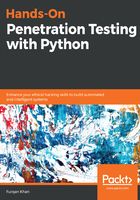
Conventions used
There are a number of text conventions used throughout this book.
CodeInText: Indicates code words in text, database table names, folder names, filenames, file extensions, pathnames, dummy URLs, user input, and Twitter handles. Here is an example: "To use the Python Terminal, simply type the python3 command in your Terminal prompt."
A block of code is set as follows:
a=44
b=33
if a > b:
print("a is greater")
print("End")
When we wish to draw your attention to a particular part of a code block, the relevant lines or items are set in bold:
my_list=[1,"a",[1,2,3],{"k1":"v1"}]
my_list[0] -> 1
my_List[1] -> "a"
my_list[2] -> [1,2,3]
my_list[2][0] -> 1
my_list[2][2] -> 3
my_list[3] -> {"k1":"v1"}
my_list[3]["k1"] -> "v1"
my_list[3].get("k1") -> "v1
Any command-line input or output is written as follows:
import threading
>>> class a(threading.Thread):
... def __init__(self):
... threading.Thread.__init__(self)
... def run(self):
... print("Thread started")
...
Bold: Indicates a new term, an important word, or words that you see on screen. For example, words in menus or dialog boxes appear in the text like this. Here is an example: "Click on the Start Crawling button."